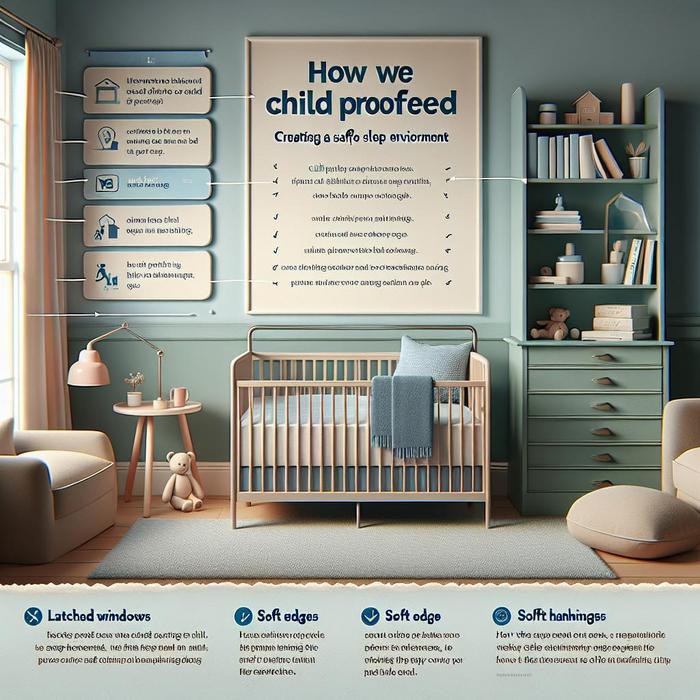Understanding the Importance of Childproofing
When you become a parent, safety becomes a top priority. It may seem like an endless list, but one of the most important tasks is to childproof your home, especially the bedroom. From securing furniture to creating a safe sleep space, we must reevaluate the safety of our surroundings. This article will provide practical child-proofing tips and advice on creating safe sleep spaces.
Identifying Potential Hazards
Before you start childproofing, it’s essential to identify potential hazards in the bedroom. First, examine the room from your child’s perspective. Get down on your hands and knees to see what they might see or reach. Remember, what may be commonplace to an adult could be a potential danger to a child. A comprehensive guide to childproofing can be a great way to start.
Tips for Transforming Your Bedroom
- Secure Furniture: Any pieces of furniture that can tip over need to be secured to the wall. This includes bookcases, dressers, and TVs. Additionally, remove any tempting climbable objects near these items.
- Child-safe Windows: Window safety is often overlooked. Install window guards or stops to prevent your child from opening windows and falling.
- Electrical Safety: Cover outlets with safety plugs or outlet covers. Secure all loose cords, such as those from blinds or electronics, out of reach. It’s worth debating whether fairy lights are safe in a child’s room. They can pose a strangulation risk.
- Safe Bedding: When it comes to safe sleep spaces, less is more. Avoid pillows, blankets, bumpers, and stuffed animals in cribs as they can pose suffocation risks. If you want to understand more about safe sleep practices, you may find our article on identifying baby’s food sensitivities helpful.
Creating a Child-friendly Environment
Childproofing is about both preventing accidents and creating an environment where your child can explore safely. Consider implementing Montessori principles in the bedroom by creating a Montessori bedroom. This style encourages independence, learning, and growth, all within a safe and controlled environment.
Toddler-proofing the Bedroom
As your child grows, so do their capabilities and curiosity. Toddler-proofing is the next step after baby-proofing, and it requires some additional measures to ensure safety. A valuable resource could be this article on tips for toddler-proofing a bedroom. It is also an excellent time to establish good habits, such as keeping toys tidy to avoid trip hazards. Don’t forget to secure large, heavier items that could tip over.
Remember, childproofing is a continuous process. As your child grows and their abilities expand, you must adapt and adjust accordingly. Creating safe sleep spaces and following our child-proofing tips can offer peace of mind and offer your child a safe environment to grow and thrive.
Cross-checking for Hidden Dangers
Childproofing is not a one-time task. It requires consistent evaluation and re-evaluation as your child grows and develops new skills. Cords might need to be tucked away again, heavy items may need reinforcement, and corners might require padding. Regular checks can ensure that your child’s room remains a safe haven. Be especially mindful of any small objects, like coins or batteries, which pose a serious choking hazard. You may find this useful resource on preventing choking helpful.
The Controversy Around Door Locks
Adding exterior locks on toddler bedroom doors remains a controversial topic among parents; some believe it’s an essential safety measure, while others feel it can be dangerous. It’s crucial to consider all aspects of safety and weigh the potential benefits and drawbacks to make an informed decision. Always ensure your child can’t accidentally lock themselves in, and consider the implications in case of emergencies.
Considering a Montessori Floor Bed
Exploring various sleeping arrangements can greatly contribute to your child-proofing efforts. A Montessori floor bed can promote safe sleep practices by eliminating the risk of a toddler climbing out of a traditional crib and potentially falling. This resource on baby-proofing with a Montessori Floor Bed can provide you with a comprehensive guide.
Investing in Safety Devices
There are various childproofing products on the market that can assist in making a toddler’s bedroom safe. These can include:
- Corner Guards: They protect against sharp furniture corners.
- Sliding Door Locks: These can prevent access to wardrobes or drawers.
- Window Locks: Provide added safety to windows already fitted with guards or stops.
- Non-slip Mats: These can prevent slips and falls, especially around bedtime.
- Stove Guards: They can be used if the bedroom contains a fireplace or heater.
Respecting Your Child’s Independence
While safety should always be the priority, remember the importance of your child’s independence. Childproofing shouldn’t limit their ability to explore and learn about their surroundings. Striking a balance between safety and independence can be challenging, but it’s necessary for their development.
Knowing When to Ask For Help
Finally, remember that it’s okay to not have all the answers. Asking for help or advice from experienced parents or reading relevant discussion threads can provide invaluable tips and guidance. Moreover, professional help is always an option. Certain companies specialize in assessing homes for potential child safety threats and providing recommendations.
Continuous monitoring and adapting to your child’s needs are essential parts of childproofing. Armed with practical tips and knowledge, you can ensure the safety of your child, all while facilitating an environment conducive to learning and exploration.
